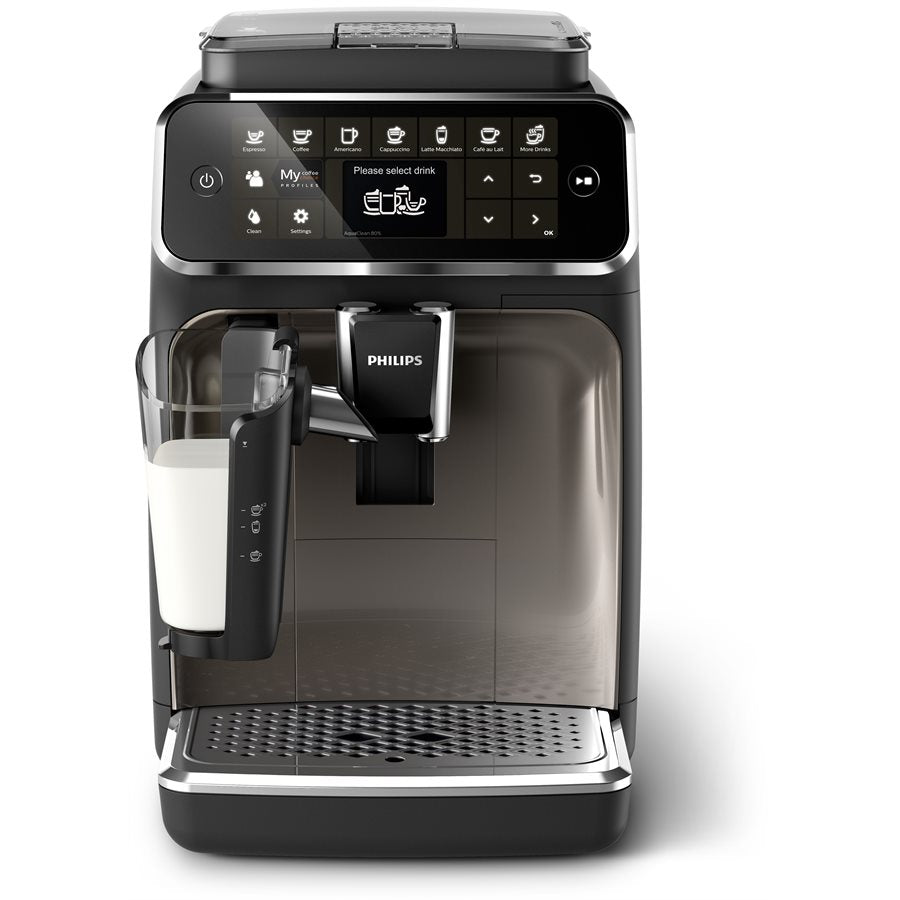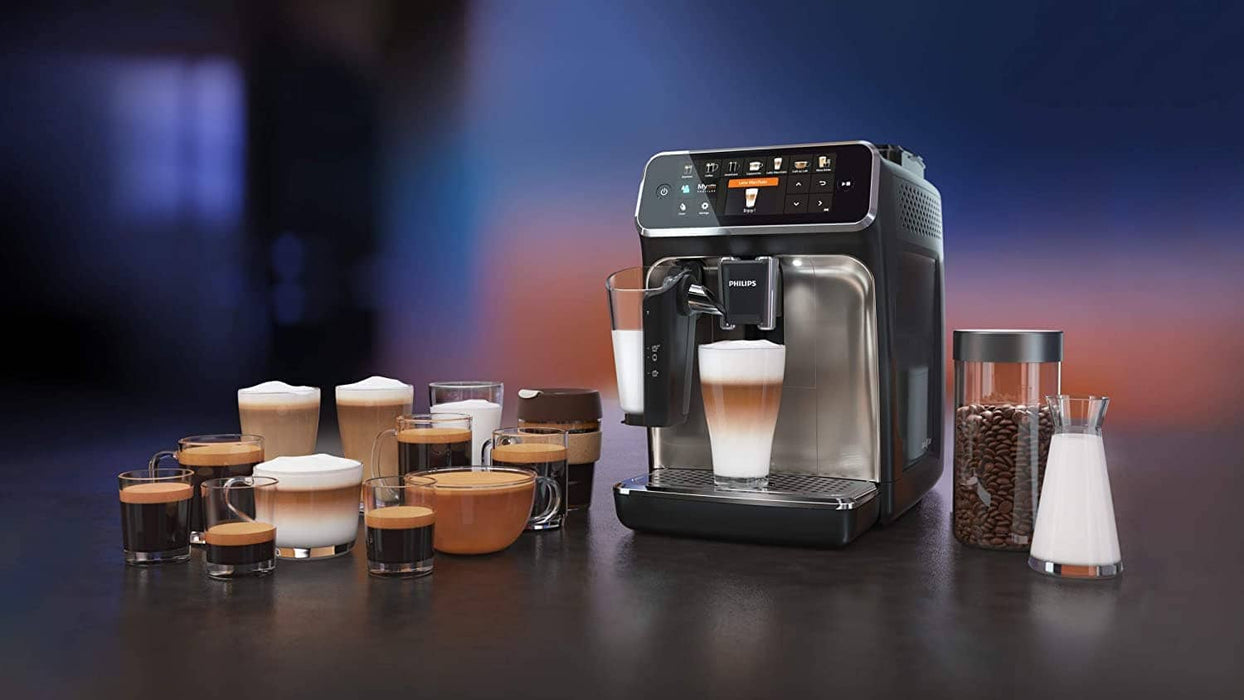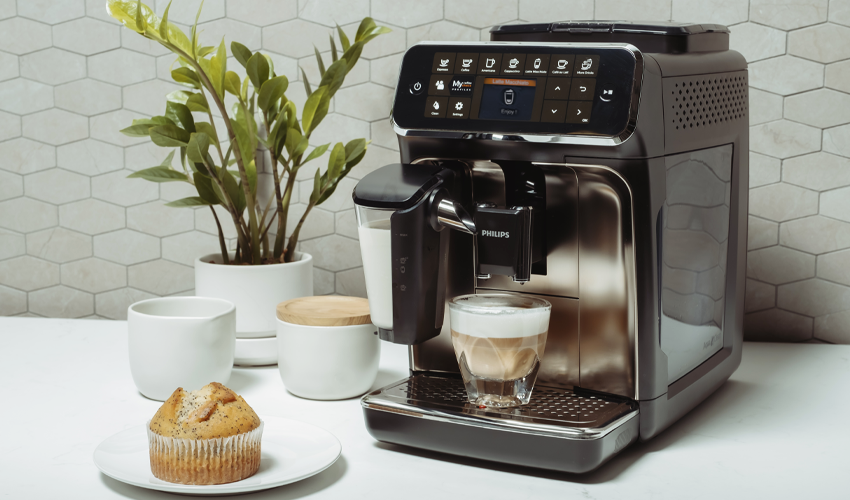#1: Philips LatteGo 5400

- Wide variety of drinks
- Advanced customization
- User profile options
#2: Philips LatteGo 4300

- Basic milk frother
- Small water tank
- Noisy grinder
Coffee has always been a part of my daily routine, but my relationship with it has evolved over the years. I used to settle for basic drip coffee machines or whatever was convenient. But once I discovered the joy of espresso-based drinks, I knew I needed something that could deliver that barista-quality experience at home. That’s when I started my journey with the Philips LatteGo 5400 vs 4300 espresso machines. After spending several weeks with both machines, I was able to truly understand their differences and how each one fits into a coffee lover’s life. Ultimately, I found that the Philips 5400 vs 4300 comparison was more aligned with my preferences and daily habits.
Why I Needed a More Advanced Machine: Philips LatteGo 5400 vs 4300
Before diving into the Philips LatteGo 5400 vs 4300 comparison, it’s important to know what led me to these machines. I was looking for an espresso maker that not only brewed strong, flavorful coffee but also made it easy to prepare milk-based drinks like lattes and cappuccinos. Both machines fit the bill, but as I delved deeper into their features, I found that the 5400 offered much more versatility for my needs. With its ability to prepare a wider variety of drinks and its superior programmability, the 5400 quickly became my favorite.

Philips LatteGo 5400 vs 4300: A Daily Companion in the Kitchen
One of the things I immediately appreciated about both the Philips LatteGo 5400 vs 4300 was how they integrated seamlessly into my kitchen routine. Both machines are compact enough to fit on my countertop without taking up too much space, and their sleek designs were a welcome addition to my morning setup. But it was the 5400 that stood out during my daily use. Its easy-to-navigate touch screen and faster brewing times made it the go-to choice when I was in a rush.
For someone who starts their day with a cappuccino, the 5400’s ability to store my favorite coffee settings was a game changer. Instead of adjusting the settings each morning, I could simply press a button, and my preferred coffee strength, temperature, and milk froth would be ready in minutes. This saved me a lot of time, especially on busy mornings.
Coffee Quality: The True Test of Philips LatteGo 5400 vs 4300
Now, onto the most important part of any espresso machine comparison—coffee quality. When testing the Philips LatteGo 5400 vs 4300, I paid close attention to the flavor profile of each cup. I have to say, both machines delivered excellent results, but there was something extra in the 5400 that made my coffee stand out. The 5400 produced a more robust and well-rounded espresso, with a perfect crema every time. It also allowed for more precise control over the coffee grind size, which played a huge role in achieving the flavor I preferred.
While the 4300 still produced a good cup of coffee, I felt that the 5400 consistently provided that café-quality espresso that made me feel like a barista in my own kitchen.
The LatteGo Milk System: How It Elevated My Coffee Experience
One feature that both the Philips LatteGo 5400 vs 4300 share is the LatteGo milk system, and I have to say, it’s one of the best milk-frothing systems I’ve ever used. The fact that it’s easy to attach and clean is already a huge plus, but what really made a difference was the consistency of the froth. Whether I was making a cappuccino, macchiato, or flat white, the LatteGo system always delivered silky, smooth microfoam that took my drinks to the next level.
However, with the 5400, I noticed that the milk frothing process was slightly faster, and the ability to control the froth’s texture and amount gave me more flexibility. I loved how I could adjust the froth settings for different types of drinks, making each cup feel personalized.

Coffee Quality: The True Test of Philips LatteGo 5400 vs 4300
Now, onto the most important part of any espresso machine comparison—coffee quality. When testing the Philips LatteGo 5400 vs 4300, I paid close attention to the flavor profile of each cup. I have to say, both machines delivered excellent results, but there was something extra in the 5400 that made my coffee stand out. The 5400 produced a more robust and well-rounded espresso, with a perfect crema every time. It also allowed for more precise control over the coffee grind size, which played a huge role in achieving the flavor I preferred.
While the 4300 still produced a good cup of coffee, I felt that the 5400 consistently provided that café-quality espresso that made me feel like a barista in my own kitchen.
The LatteGo Milk System: How It Elevated My Coffee Experience
One feature that both the Philips LatteGo 5400 vs 4300 share is the LatteGo milk system, and I have to say, it’s one of the best milk-frothing systems I’ve ever used. The fact that it’s easy to attach and clean is already a huge plus, but what really made a difference was the consistency of the froth. Whether I was making a cappuccino, macchiato, or flat white, the LatteGo system always delivered silky, smooth microfoam that took my drinks to the next level.
However, with the 5400, I noticed that the milk frothing process was slightly faster, and the ability to control the froth’s texture and amount gave me more flexibility. I loved how I could adjust the froth settings for different types of drinks, making each cup feel personalized.
Tailoring My Drinks: Philips LatteGo 5400 vs 4300
Another aspect where the Philips LatteGo 5400 vs 4300 differed was in drink customization. As someone who likes to change things up, the 5400's broader range of settings made a big difference in how I could tailor each cup to my liking. Whether I wanted a stronger espresso shot or a milkier latte, the 5400 gave me full control. I could tweak everything from coffee strength to the temperature of the milk, allowing me to experiment with different flavors and combinations. The 4300, while capable, didn’t provide the same level of control, making it feel less flexible.
My Favorite Recipes with the Philips LatteGo 5400
One of the joys of owning a machine like the Philips LatteGo 5400 is experimenting with different coffee recipes. I found myself trying out all sorts of drinks, from a classic latte to more creative options like a cinnamon-spiced cappuccino. The 5400 made it easy to explore these recipes, thanks to its customizable settings. I could adjust the coffee strength for a bold macchiato or create a mild flat white with just the right amount of frothy milk.
The 4300 also performed well with basic espresso and milk drinks, but it felt more limited in terms of customization. For someone like me who enjoys tweaking recipes, the 5400 was the clear winner.
Long-Term Ownership: What to Expect from the Philips LatteGo 5400 vs 4300
Having used both the Philips LatteGo 5400 vs 4300 over an extended period, I can confidently say that both machines are built to last. The 4300 is a solid, reliable option, but the 5400 feels more durable overall. Its sturdier build and more advanced components suggest that it may hold up better in the long run, especially with daily use.
Another aspect I appreciated with the 5400 was its ease of maintenance. Both machines have a quick clean function, but the 5400 goes a step further with more automatic cleaning programs, which kept the machine running smoothly without much effort on my part.
Energy Efficiency: Philips LatteGo 5400 vs 4300
Energy efficiency was another factor I considered while using both machines. In the Philips LatteGo 5400 vs 4300 comparison, both machines performed admirably. They both feature energy-saving modes that automatically switch the machines off after a period of inactivity, which is great for saving electricity. However, I found that the 5400 seemed slightly more efficient, thanks to its faster heating element. It reached brewing temperature quicker, which meant less energy used overall.
The Perfect Fit for Coffee Lovers: Philips LatteGo 5400 vs 4300
At the end of the day, the Philips LatteGo 5400 vs 4300 comparison comes down to personal preferences and how much control you want over your coffee-making process. If you’re like me and you enjoy customizing your drinks, experimenting with different settings, and having a bit more control over your coffee’s flavor, the 5400 is the perfect fit. Its broader range of settings, premium features, and superior milk frothing system make it the better choice for those who want a more advanced coffee experience.
That being said, the 4300 is still an excellent option, especially if you prefer simplicity and don’t need as many customization options. It’s a reliable machine that delivers great coffee, but for those who want a bit more out of their espresso maker, the 5400 is the way to go.

Product Review Conclusion
In conclusion, after testing both the Philips LatteGo 5400 vs 4300, I found that the 5400 offers more versatility, customization, and overall value for someone who enjoys exploring different coffee flavors and styles. Its user-friendly touch screen, quicker brewing times, and superior milk frothing system make it a standout machine in its class. While the 4300 is still a great choice for those who prefer simplicity, the 5400 elevates the home coffee experience to a whole new level.
FAQs for Philips LatteGo 5400
Q: How many different drinks can the Philips LatteGo 5400 make?
A: The Philips LatteGo 5400 can make up to 12 different drinks, including espresso, cappuccino, latte macchiato, americano, flat white, and more. It also allows for personalized drink customization by adjusting coffee strength, quantity, and milk froth.
Q: How does the LatteGo milk system work?
A: The LatteGo milk system mixes milk and air at high speed in the frothing chamber, creating a creamy layer of froth for milk-based drinks. It’s easy to assemble, clean, and is dishwasher safe, which simplifies maintenance.
Q: Can I save my preferred drink settings?
A: Yes, the Philips LatteGo 5400 allows you to save your customized drink preferences. You can adjust settings like coffee strength, temperature, and milk froth and save them for future use, making it easy to recreate your favorite drinks.
Q: Is the Philips LatteGo 5400 easy to clean?
A: Absolutely. The LatteGo milk system is a two-part system without any tubes, making it very easy to clean. It is dishwasher safe, and the machine also has an automatic cleaning cycle that keeps it well-maintained between uses.
Q: How long does it take to brew a coffee with the Philips LatteGo 5400?
A: The Philips LatteGo 5400 heats up quickly, and it typically takes less than a minute to brew an espresso. Milk-based drinks, such as cappuccinos or lattes, may take a little longer but are still prepared efficiently within a couple of minutes.
Q: Can the Philips LatteGo 5400 use pre-ground coffee?
A: Yes, the Philips LatteGo 5400 has a bypass doser that allows you to use pre-ground coffee. This is particularly useful if you want to use a specific blend or if you prefer decaffeinated coffee.
Q: How often does the machine need descaling?
A: The Philips LatteGo 5400 features a built-in AquaClean filter, which reduces the need for frequent descaling. With regular use of the AquaClean filter, you can make up to 5,000 cups of coffee before needing to descale.
Q: Is the Philips LatteGo 5400 suitable for a busy household?
A: Yes, the Philips LatteGo 5400 is ideal for a busy household. Its fast heating time, large water reservoir, and intuitive touch screen make it easy to brew multiple cups of coffee quickly. Additionally, its automatic cleaning functions and large capacity help reduce downtime between uses.
Q: How customizable are the drinks?
A: The Philips LatteGo 5400 allows for a high level of customization. You can adjust the strength, temperature, and volume of your coffee and milk-based drinks. This flexibility makes it easy to tailor each cup to your exact preferences.
Q: Can I adjust the grind settings on the Philips LatteGo 5400?
A: Yes, the machine has 12 adjustable grind settings, allowing you to fine-tune the coarseness of the coffee grounds based on your preference, which directly affects the flavor profile of your espresso.
